Even though we took a while to gather thoughts in this interview by Singapore Art Book Fair, a couple of things mentioned within haven't quite happened yet (what is Loose Assemblies? We'll explain soon!). Still, it was a great opportunity to talk about what the infoshop library is about, our approach to zines, print, and art, what dreams we have, and how we hope to organise. Thank you to the team for your questions and for publishing! We're including a few photos from our (pre-revamped) room and an excerpt below, with more in the link.
"In any case the zine as a form shouldn’t just stand on its own, but supplements other media and scales of action. Perhaps its usefulness comes in being accessible, still novel, intimate, inconspicuous, and mobile. When we talk about the political, it’s about an emancipatory horizon, about figuring out how life can be shared and held in common. Not just resisting capitalist catastrophe, but to overcome and thrive. There, we will need to have art around for healing, contemplating, educating, and sharing, which can be collective and generalised, happening alongside other needs and interests. We should start imagining what that could be like, together with how to get there and the things we can be doing right now to bring that into being."
The full interview is republished below:
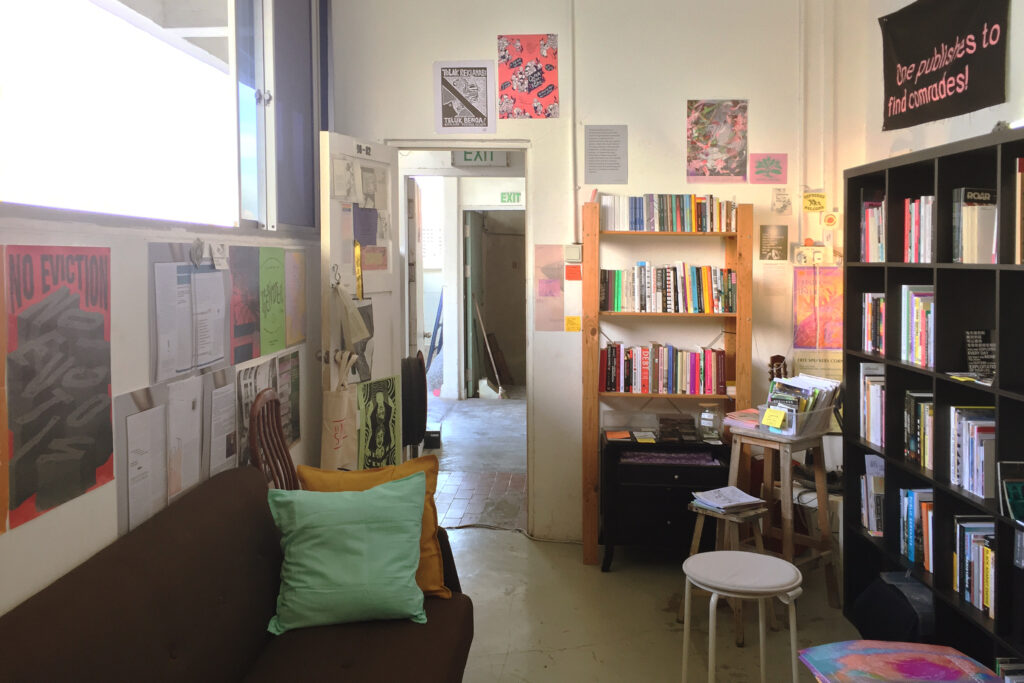
SGABF: Firstly, can you tell us more about wares?
WARES (W): wares is a reading library and an infoshop project holding open space for people to study, rest, gather, share, and agitate together beyond the impositions of capital. A big motivation for us is the breaking of isolation and alienation that defines so much of life today, towards building capacities for collective autonomy and care.
Apart from sharing through social media reading material on emancipatory thought and praxis, wares has been physically nestled at the collaborative project space soft/WALL/studs since 2018. There we use a library room shared with the host group’s own library, so when you visit us you’ll encounter not only our collection of books, zines and printed matter but also a range of literature reflecting diverse creative interests and practices, which together is kept open and cared for by volunteers.
We have been experimenting with publishing, live events, and online projects, connecting with friends both here and beyond these artificial territorial borders who are working along similar lines for life in common. In June, while preparing new material including stickers, posters, and zines for SGABF, we will be announcing a semi-regular gathering framework Loose Assemblies and also opportunities for our visitors and friends to volunteer with caretaking and other kinds of support.
SGABF: How would you describe the people who enter wares?
W: We’re thankful for everyone who makes the trip and dwells with the library! If speaking only in terms of occupation, it’s been a mix of mostly students, artists, researchers, but really varied; people who are interested in text, reading, art, critical theory, an autonomous politics, or just a sense of freedom afforded by a space not demanding a “minimum spend”. Some enjoy the quiet space to work on things, some are simply curious and visit after hearing about it, and others know what’s up and return bringing friends who are looking for connection.
When we hosted the live ambient music nights Against the Disquiet, more people came through who might not have, probably due to a friend playing or the novel suggestion of quiet listening and reading, and it helped build our confidence to try other things to meet more people. This follows from the otherwise we’d like to cultivate, rejecting the tendency of interacting with spaces as mere consumers of commodities and experiences. Admittedly it’s all still a very small subset of people who live and work in Singapore, with evident gaps in physical, affective, and language accessibility, and not even engaging with folks in the local area.
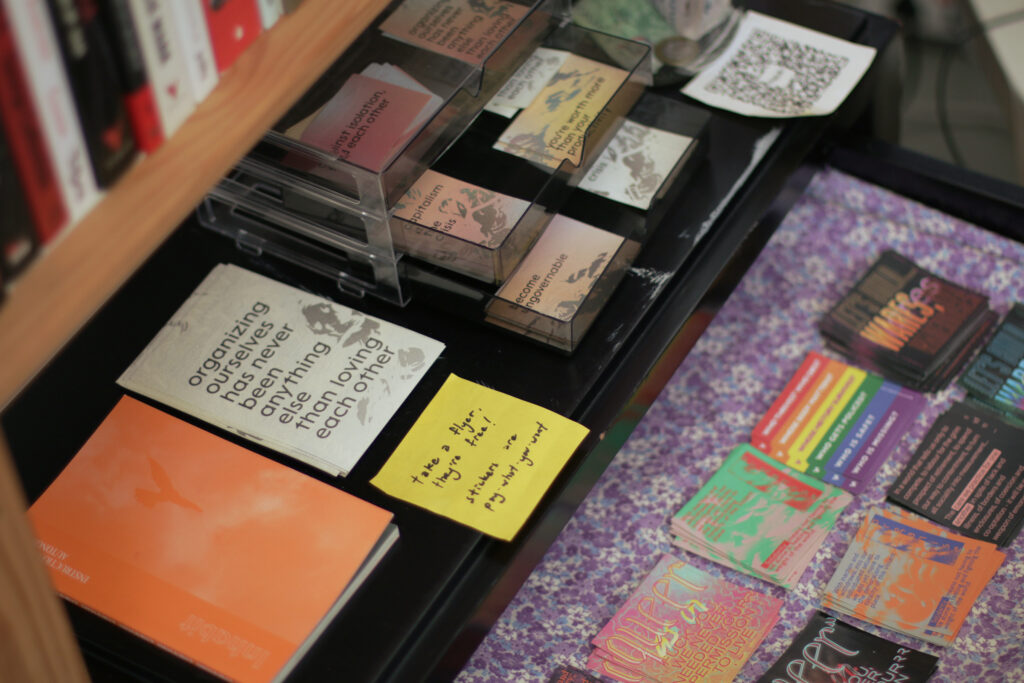
SGABF: Being in a physical space, how does wares select what goes into the infoshop library? What are some publications wares focuses on in the process of curation?
W: We haven’t quite run out of space just yet (we may need more shelves!), so that’s not really an issue when it comes to selection. Money though, for purchasing books and paying rent, and finding time and volunteers to keep the space open, are more pressing limitations to what we’re doing.
We select publications based on their content and relation to what we want to imagine, see, and build. We have also received donations that reshape what is relevant, broadening what we think of as interesting. Most of our library has to do with anti-capitalist autonomous politics, but weave in and out of various subjects, styles, and concerns, intersecting with queer and trans life, abolition and decoloniality, struggles for justice, non-state futurity, hidden histories, visual cultures (including self-publishing), and so on. We are definitely looking for more material from this part of the world, things that break from normative society, things that confront race, gender, ability, health, biopolitics, logistics, work, nationalism, and authoritarianism.
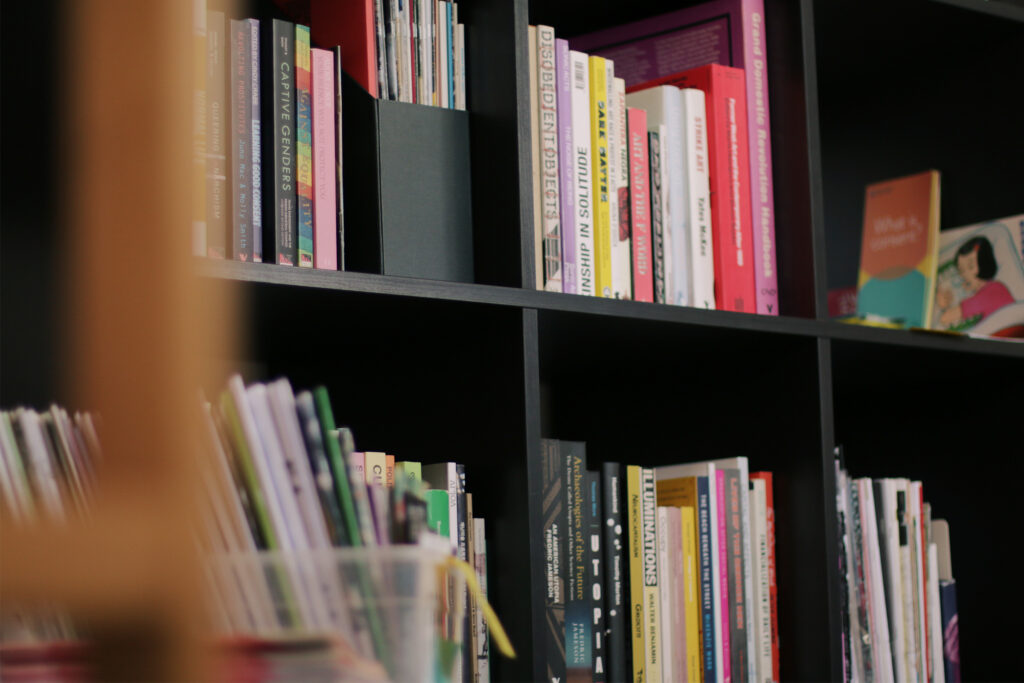
SGABF: As a collector of zines, is there a sort of belief that this printed format is an economical means of expression to be obtained? How might this have changed from the past and today?
W: Yes, because it’s still possible to print cheap, even if selling cheap is determined by more than that. The fanzine is historically defined by a sort of defiant spirit of making do with what one has, and that was made possible by the affordability of reproduction by photocopying. But what’s more vital is that this made it possible for pretty much anyone to publish, to be making, to be creative, to be in conversation with a friend or community through this physical medium. Which means zines were also typically distributed at cost or traded for other zines within such informal networks.
There’s a kind of understanding that their making and circulation are intimate and protected from a market or profit logic, like a gift economy, because often the content within is not meant for anyone outside the network anyway, which also accounts for aesthetics that are experimental and not necessarily marketable. To be clear, the technology is just a vehicle for that spirit; many people are still committed to such an ethos but may not deal with zines per se.
If things have changed, it might be that the internet has offered access to an effectively free platform for publishing and sharing with practically no limits to reach or scale, and digital technologies, be it technical tools for photography, image and video editing, print layout, and so on, have proliferated along with the knowledge to use them (and the burgeoning “creative industries”), creating situations where a self-published object could rival the formal qualities of professional mass-productions of the past. It’s also allowed more people to learn about the zine as a subcultural form, to use it on their own terms. But if a “zine” now looks and feels “professional”, should it fetch a “commercial price”? Should we call every book that is saddle-stitched a zine? How does it relate to historical lineages? How do such changes shape how the form is used and understood in future?
Another point to note would be that almost everyone who may make (or read) a zine now lives with the precarity of the so-called gig economy. The economic conditions that allowed for “free time” to make a book without turning a profit may well be over (and likely never existed for many, many people) (though if we look at online media like memes, vines, or youtube essays, clearly cultures and voices exist anyway without expectation of pay). So that’s something to grapple with – how to reclaim time and life from the monetisation of everything while not falling into the oversimplified trap of thinking selling equates to capitalist.
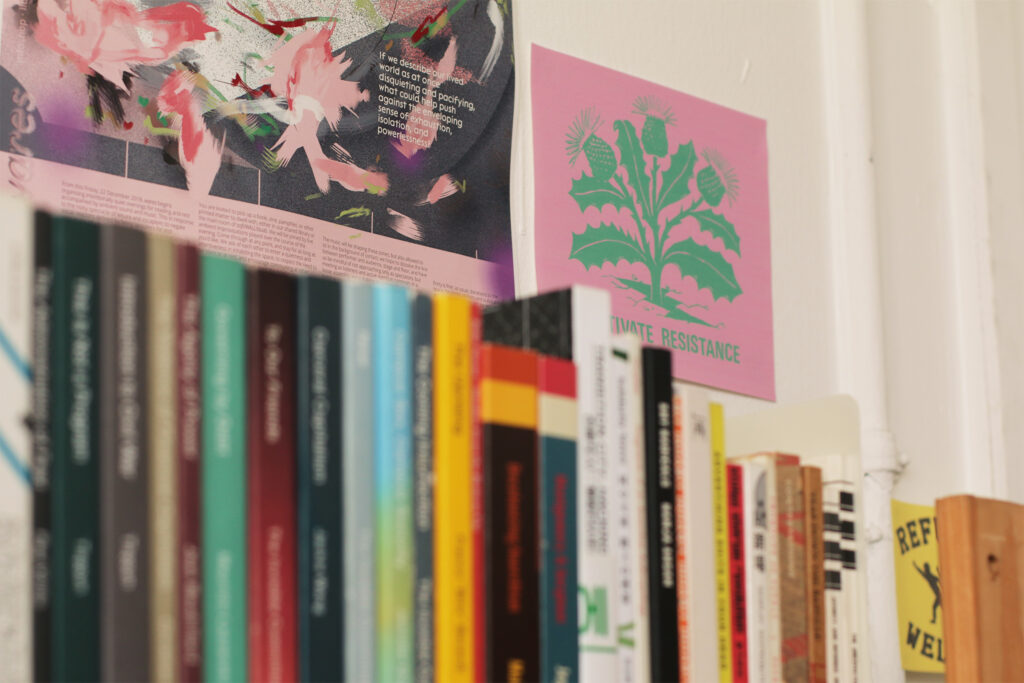
SGABF: The purported distinctions between different print forms such as zines and art books, and how aestheticisation reflects a fetishisation of material and visual form over content, was previously discussed. Can you elaborate more on this?
W: To be clearer, we were talking about "artistic" or aestheticised zines, and how the problem with them isn't that they're artistic (which suggests a forced binary between the artistic and the "radical", or what’s intellectual and not, or shallow and deep), but rather lies with how art is perceived and practiced here (and many other places heavily shaped by capitalism and associated processes), how it represents the foreclosure of life and possibilities, masking and distracting from urgencies.
What we mean is that, behind the book object, fair, exhibition, or aesthetic theory, regardless of whether something positions itself as “high art” or whatever, what function do these play within the particular society we happen to inhabit? Is art itself being framed in a way to prevent us from asking questions, from even thinking about them, much less acting on them? Is art simply resigned to being an insulated space for distant contemplation, and then despair? A space to create and reify value, pacifying through beauty, with material excess literally declaring, “everything’s fine”?
We could even look to the labour that keeps all that vibrancy afloat: if everyone’s tired just producing to survive, not even in conversation about anything other than the producing, what is any of it even for? This is part of a critical position we’ve been developing alongside the counter-spectacle counter-event #NAWartweek and want to extend as a basis to the things we do.
If fetishisation of form occurs, it’s probably because it’s simpler, quicker, more competitive, fitting in with consumptive habits and the political context. Which is to say, it’s culturally expected that form is privileged over content. Maybe this is cynical, but the bottom line is this isn’t sustainable or inspiring. We should see art as an industry producing media content (that other sense, as in the content farm), competing with anything else visual and experiential that as a whole maintain a continuation of things. From lightshows to street parties, biennials to lifestyle festivals, zines and independent publishing shouldn’t be reflecting or extending this paradigm, but smashing it.
So when we talk about being a reading library, maybe there’s another dimension to it too, which is that we want to make space to collectively learn how to read situations and currents so that change can be strategic. In a way, this is about not judging a book by its cover – how do we read art, advertising, grand spectacle, the city, polish and quality, valorisation, the “first world”, and so on. Behind the surface, what’s going on structurally? How are these things enabled, what ideologies do they reinforce, what are their effects on lives? Like when we look at a street demonstration, we can’t just assume that displays of “people power” is simply a good thing, as we know this is a form that’s also used by nationalists, reactionaries, and people who want to preserve a status quo.
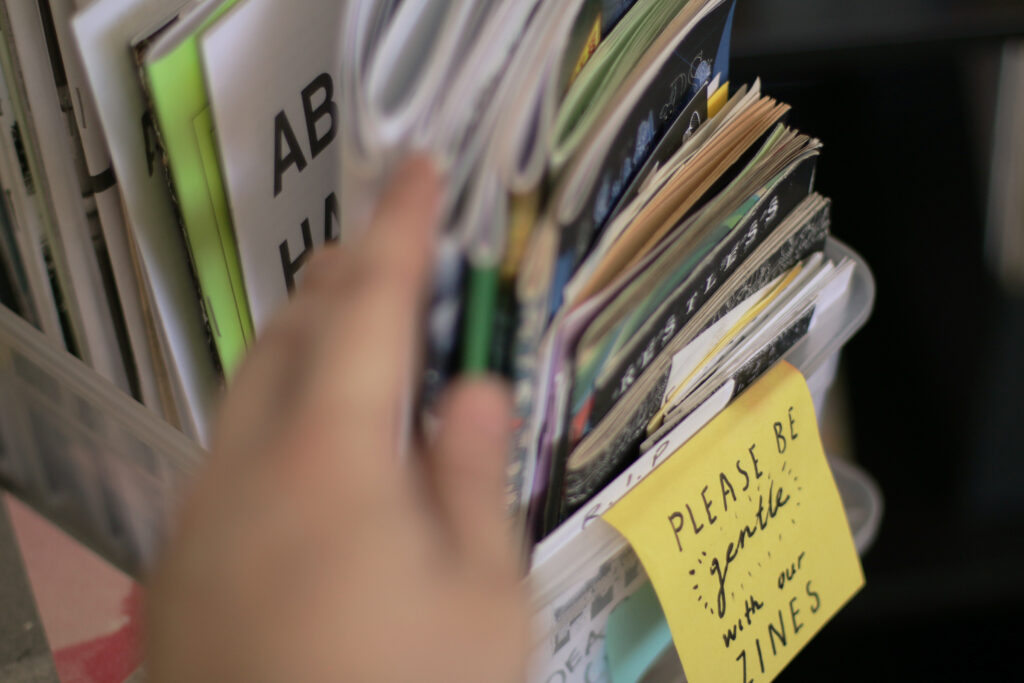
SGABF: Have zines today been co-opted by capitalist modes of thinking, altering what is produced or their final forms? We think about why certain institutions might stock zines and whether the values they serve stem more from their position as aesthetic pieces of consumption as opposed to their social contents, nullifying their positions as pieces of rebellion. In a sense, resistance cultures have been subsumed by material cultures.
W: This is a really big question. To follow from before, certainly the material conditions and social relations mediated by capital shape how we do things and why. Capitalist logics, even when it takes the form of liberalism (like when people say democracy is about the freedom to make individual choices, which parallels how “politics” is often thought of as choosing parties of management), maintain scarcity and seek accumulation and competition. These are reflected as costs on choices.
No doubt there are institutions with resources collecting and archiving self-published printed matter and zines, which shouldn’t be an issue regardless of whether that’s done as an overview of a form or guided by topical focus. After all, they are not buying up the supply or altering the content, the rest of which can still reach their intended audience. They should do more, of course, if they truly cared about support. But when capitalists – individuals, corporations and institutions alike – begin commissioning the making of zines and other media, tapping on the image of the cool and “artisanal" co-opting the language of autonomy and liberation, as has happened recently with a huge luxury fashion brand, there’s a danger where the available pathways in which people make or speak (or are able to be seen and heard) become monopolised.
It’s not that their money may be “dirty” (isn’t all of it?), or that it’s “selling out”, but more about the enclosures that are thrown up, arbitrarily shifting what “viable” or “acceptable” means, limiting options and choices when survival is at stake. Brand partnerships may present themselves as opportunities to sustain an artistic career, but they are where artistic labour is further put into competition, weaponised and depoliticised, perhaps driven by interests of property and image – as art-washing and “woke”-washing for entities that are very likely exploiting labour or gentrifying elsewhere. In Singapore, the state itself is a big enabler of such arrangements.
Artists as art workers need to make tactical decisions regarding who they choose to work with and who they will sell their labour to, as well as be in positions to negotiate what they might use those platforms and resources for if they do. Those doing the commissioning may deploy platitudes like “biting the hand that feeds you”, which would tellingly reveal what kind of power they hold. Can we imagine a world where the only way we can have time to make or say anything is when those who have money would pay for it?
But there’s also another kind of power, found in the forming of communities based on mutual aid and cooperation, sharing of resources, distributed authorship, and collective struggle. Here, one also doesn’t have to be an artist to make something, nor an activist to have a voice. This is going to be something vital as media content and communication-consumption platforms are consolidated and legal frameworks hardened, how people can overcome those costs and enclosures.
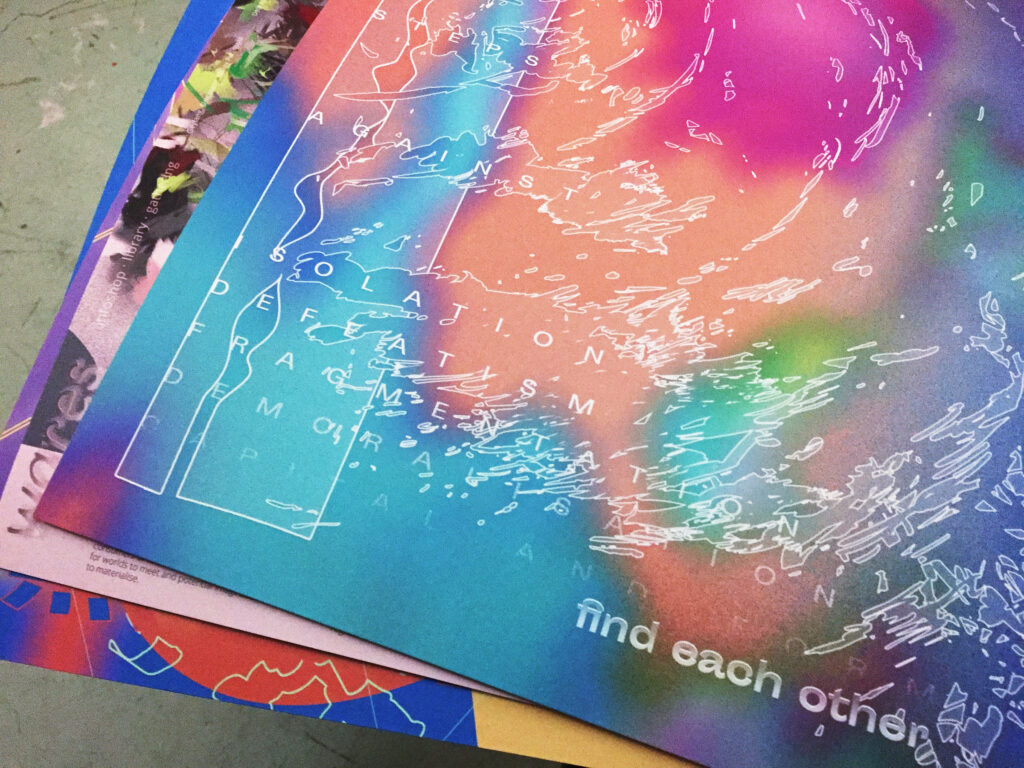
SGABF: The zine has a history of being an object of counter-culture and political campaigns. How do you see the purpose of zines evolving from past, present to future? Has the dominant capitalist system already altered this idea of an object of counter-culture as a form of resistance?
W: We’re not researchers of publishing culture, so we can’t speak to just how an entire form or practice has shifted. For that, check out this piece by Display Distribute charting histories and types of independent publishing closer to this region.
What we have observed, and based on assumptions too from Singapore, is a growth in recent years of the aestheticised object, of zines and light publications focused on photography and visual work. As mentioned earlier, this has to do with technology, but is probably also shaped by what gets taught, promoted or seen, coloured by an already existing general void in critical engagement with the social and political in the visual field. There is a separation of worlds, making possible absurd situations where established designers making “zines” are surprised to learn about the existence of punk zines from 2000s Singapore. Even then, rebellion ends up being treated as a look, like a surface aesthetic to dress sneakers, in the same way zines are understood as a form, divorced from history and ripe for misappropriation as cultural capital.
It’s still encouraging to see people experiment with self-publishing and small-scale print art, to the extent where art book fairs are popping up everywhere, but we have to wonder if it’s plateauing, who’s gatekeeping, and what barriers of entry look like. These are still after all marketplaces, and that means one either needs to make things that can sell and turn a net profit, or support the effort with something else. What skills and looks become trendy, and what falls off the map?
Our attention, and what we’re excited by, is on folks exploring different and fresh aesthetics for politically-driven zines, making cute shit that has teeth, subverting established aesthetics of resistance, using the internet in tandem for visibility and to reach those in affinity. Like there’s some great stuff on disability, health autonomy, mental illness, prisoner support, care networks out there. So we hope to see the form used for more, combining the critical, poetic, personal, antagonistic, and moving, the visual and textual, maybe even the aural and tactile. We also hope that there can be space and interest for these to circulate and be in conversation (another thing we’d love for wares to be supporting). The object is just a form, it is up to whoever makes it and uses it to give it its content and context – and if it stops being useful, we probably should find better forms.
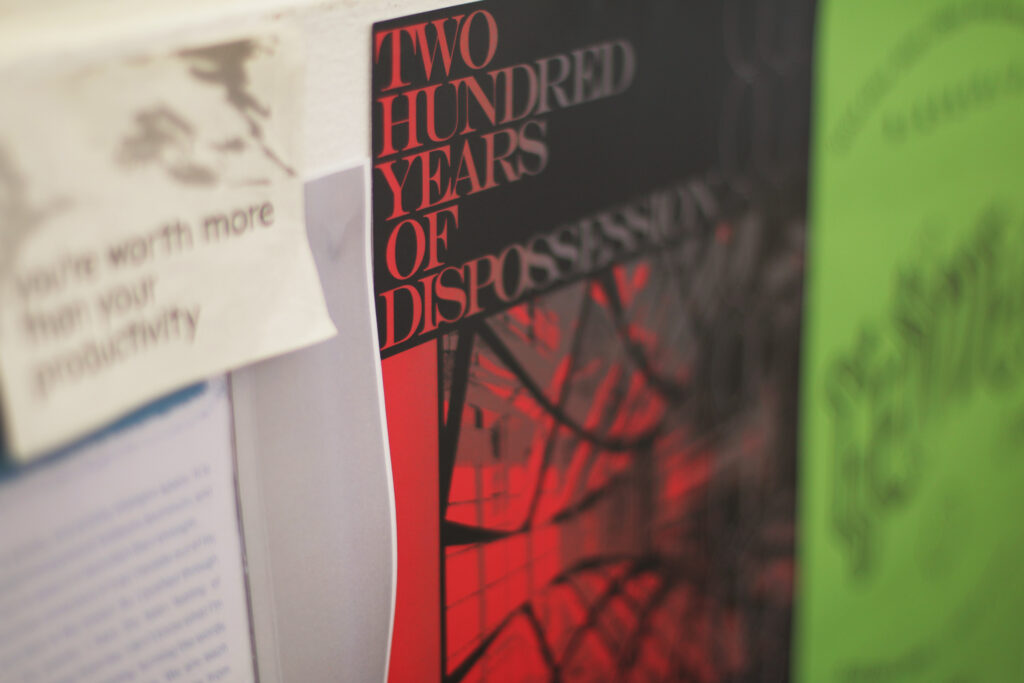
SGABF: If we look at the zine as an object of socio-political consciousness, do you think it has been an effective medium in doing so?
W: What is effective really depends on what the goal at hand is. Then there are small steps and large leaps, and we need to know, based on communication and understanding, how and when to make them. In any case the zine as a form shouldn’t just stand on its own, but supplements other media and scales of action. Perhaps its usefulness comes in being accessible, still novel, intimate, inconspicuous, and mobile. When we talk about the political, it’s about an emancipatory horizon, about figuring out how life can be shared and held in common. Not just resisting capitalist catastrophe, but to overcome and thrive. There, we will need to have art around for healing, contemplating, educating, and sharing, which can be collective and generalised, happening alongside other needs and interests. We should start imagining what that could be like, together with how to get there and the things we can be doing right now to bring that into being.
SGABF: You talked about how the way we perceive things stems from how capitalism and its structures have effectively skewed the ways we think. In your opinion, what is the alternative or ideal space?
W: This sticker should give an idea of what we’re down with, but come through our space (or table during the fair, we’ll be bringing a selection of stuff from our collection for browsing) and find out more!
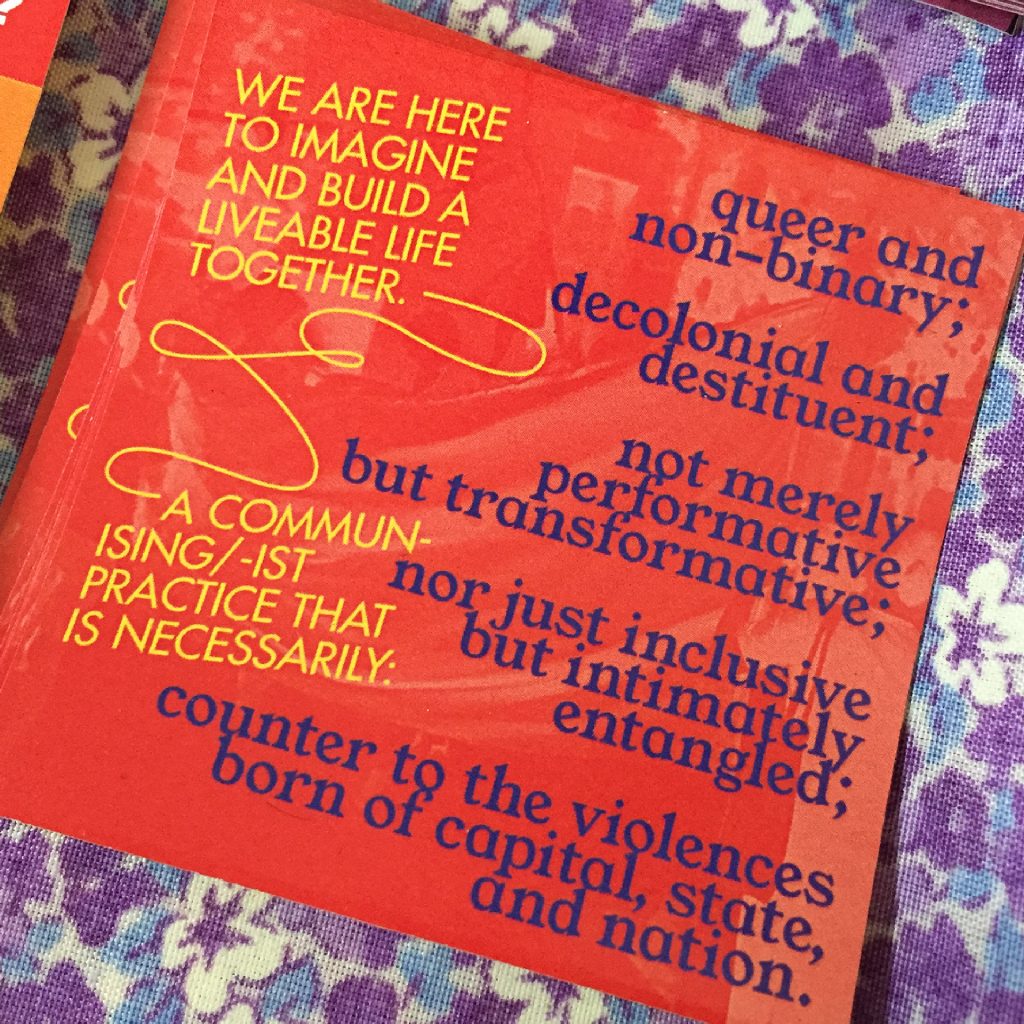
SGABF: What are some actions you feel that organisations, platforms and spaces like SGABF should take to reach out to the wider public? How do you perceive the role of wares in the larger society in general?
W: We can’t speak for SGABF, but we hope it can remain an open platform despite the pressures of economy, be an intermediary taking on negotiation with the propertied class and government (for space, patronage, logistics, and protection from the potential policing of content), help amplify creative and critical voices and platforms that have been marginalised in this crap place, and also not be alone in doing so.
wares may not be oriented in the same way, especially not in engaging with institutional bodies, but we’d like to be a node that leads to more – not numerical growth as a collective, but more like a spreading of seeds and spores into networks and autonomous infrastructures. We’re toying with ideas of mobility, exploring how to appear outside formal and safe zones, how to translate and speak with, ways where we can facilitate collective making, publishing, editing, printing, and the sharing of skills, developing languages and aesthetics, to meet and traverse the world together as accomplices.
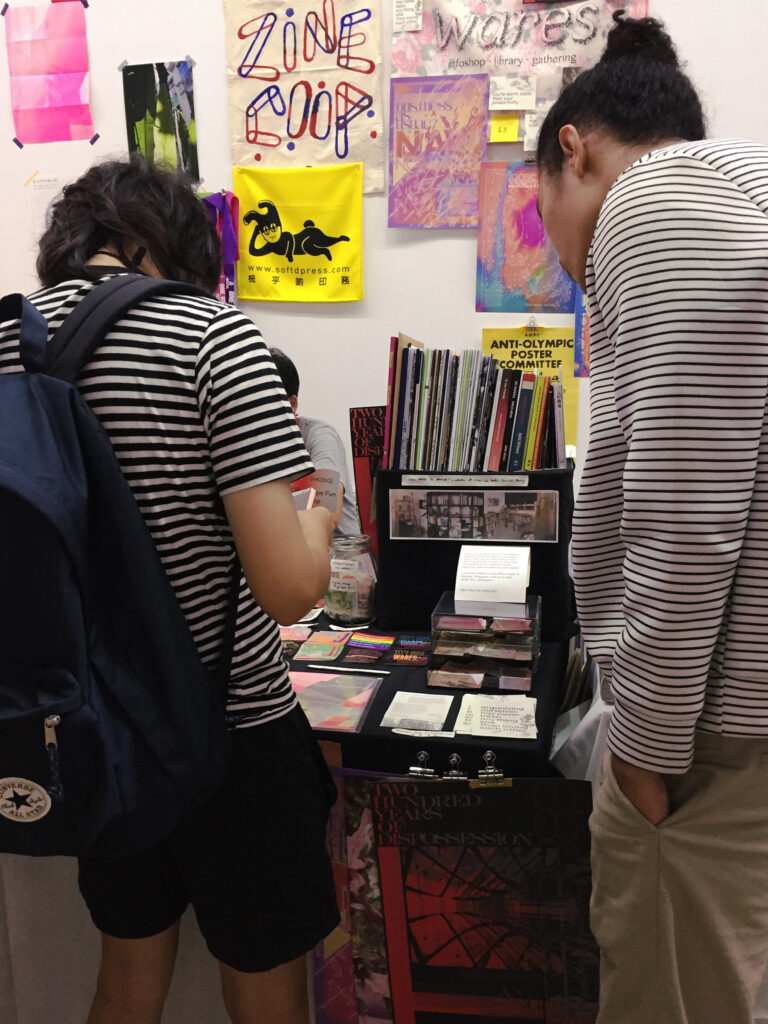
SGABF: Finally, can wares recommend up to 3 zines/art books/publications in your collection?
W: It’s tough to pick from more than 300 items, but alright!
Sick Woman Theory, The Broken Teapot, Inhabit
wares is a reading library and infoshop project collecting a tapestry of books, zines, and other printed matter. Part material and part virtual, it carves out new potentials for collective gathering, study, agitation, and autonomy beyond capital.
[The original facebook post was published on 19 August 2019, and the interview was published on singaporeartbookfair.org in July 2019, both archived here in August 2022]